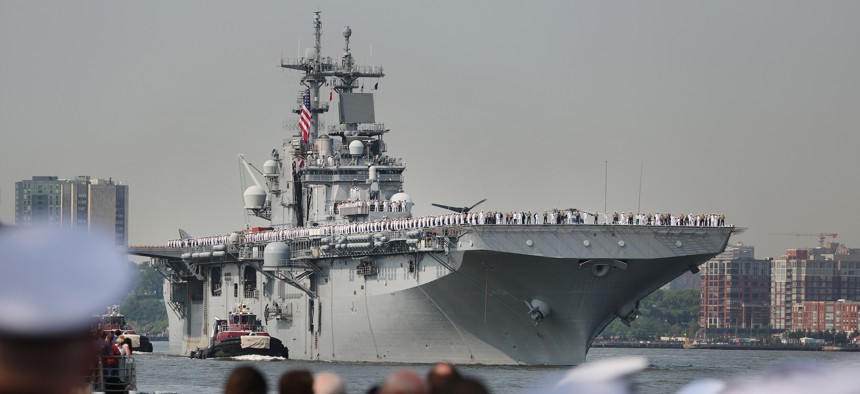
The amphibious assault ship USS Wasp arrives in New York Harbor for the annual Fleet Week event on May 24, 2023. Spencer Platt/Getty Images
Republicans Want to Ax Pentagon Budget Office That Aims to Save Taxpayers Money
GOP lawmakers say the CAPE office is ignoring their amphibious-warship directive, which DOD says arrived too late to shape the current budget.
A small Pentagon budget office whose mission is to make sure taxpayer dollars are spent well has landed in the crosshairs of Republican lawmakers who say the office is not listening to Congress.
The Cost Assessment and Program Evaluation office, known in Pentagon circles as CAPE, has found itself in the middle of a squabble over the appropriate number of Navy amphibious ships the Marine Corps needs to operate. Now, the House Armed Services Committee wants to abolish CAPE altogether.
The 2023 National Defense Authorization Act, which was passed in December when Democrats still controlled both chambers of Congress, set a requirement for 31 amphibious ships. By that point, a senior defense official said, the Pentagon’s budget was largely complete.
“We certainly take very seriously the fact that Congress has spoken on that effort, but the timing left us in kind of just a funny space in this cycle,” a senior defense official said. The official spoke on the condition of anonymity to discuss the legislation, which would have to be passed by both the Republican-led House and Democrat-led Senate and then signed by President Biden.
Amphibious ships are purchased every other year, with the most recent one ordered this year. But the Pentagon left additional ships out of the five-year spending projections in its fiscal 2024 budget request.
“We felt that we had time as part of the next [fiscal 20]25 budget build to address the new legislative requirement as well as ask some additional questions to make sure that we're … providing the Marine Corps with the lift that they need in the most cost-effective way possible,” the senior defense official said.
But House Republicans viewed the lack of ships in the five-year projections as counter to the guidance they gave in the NDAA.
“I think members are very confused as [to] why CAPE…thinks they can come back and determine…they're not gonna listen to Congress,” a senior Republican aide told reporters this week.
The House Armed Service Committee recently released draft legislation would eliminate the CAPE office in the 2024 NDAA.
“I think members have found CAPE to both slow down the acquisition process and keep adding money to programs or requirements to programs that Congress has already authorized and funded at certain levels,” the Republican aide said. “I think there's just a frustration among members that CAPE has gone further than its remit.”
Congress created CAPE in 2009, but the office’s functions and history date to the 1960s. Its mission is to “provide the Department of Defense with timely, insightful, and unbiased analysis on resource allocation and cost estimation problems to deliver the optimum portfolio of military capabilities through efficient and effective use of each taxpayer dollar.”
CAPE provides the defense secretary with options but does not make budget decisions, according to current and former defense officials.
“Those options are based on a rigorous analytic effort [done] around the hardest questions that face the department,” the senior defense official said. “All of that is in service of making sure that our resources are aligned to our strategy.”
The office often finds itself “at the center of decisions that, regardless of how they go, they're going to make somebody very unhappy,” a senior defense official said.
Today, about 160 nonpartisan civil servants and military officials work in the office. Only the CAPE director and chief of staff are political appointees.
The CAPE office has often found itself in the middle of political squabbles, regardless of the political party in the White House or Congress, because its analysis is typically cited by top defense officials for why they chose to buy, or get rid of, one weapon in favor of another. Each of those weapons—especially the ones already in the budget—has a constituency in Congress that will typically fight to get that funding flowing, regardless of whether it makes strategic sense.
During the Trump administration, CAPE was criticized for a proposal to shrink the fleet of Navy aircraft carriers from 11 to nine. In 2019, the office was also criticized for its analysis of the types of fighter jets the Air Force needed.
CAPE only does a handful of assessments each year, but they typically involve options for buying high-profile weapons programs. Its research involves the military services and combatant commands.
“Without a source of independent analysis, the [defense] secretary ends up without any ability to review competing resource requests from the services,” the senior defense official said.
The office looks across all of the military branches' budget proposals for redundancies and gaps, the officials said.
“Without a source of independent analysis, the secretary would be left just kind of having to staple all those things together and hoping that they result in a coherent joint force, as opposed to having the ability to actually look under the hood and make sure that what we end up with is a coherent joint force that is not only effective, but cost effective, and that is fully supportive of the national defense strategy,” the official said.
When the U.S. Marine Corps was recently planning to buy new MQ-9 Reaper drones from General Atomics, CAPE found the Air Force had a bunch of excess ones sitting in crates in a warehouse, the defense official said. The move saved taxpayers more than $100 million.
Today, the CAPE office is playing a major role in modernizing the military’s nuclear arsenal, which is split across the Air Force and Navy.
“Without that kind of oversight, the services left to their own devices…not through any malice, but aren't always able to see the joint priority,” the official said.





